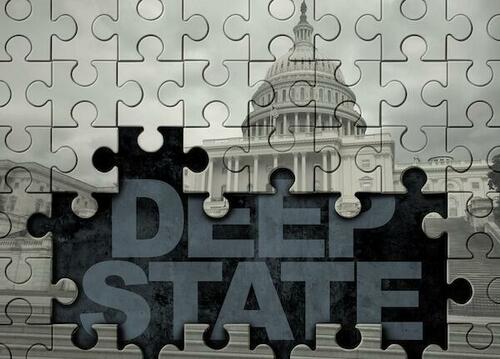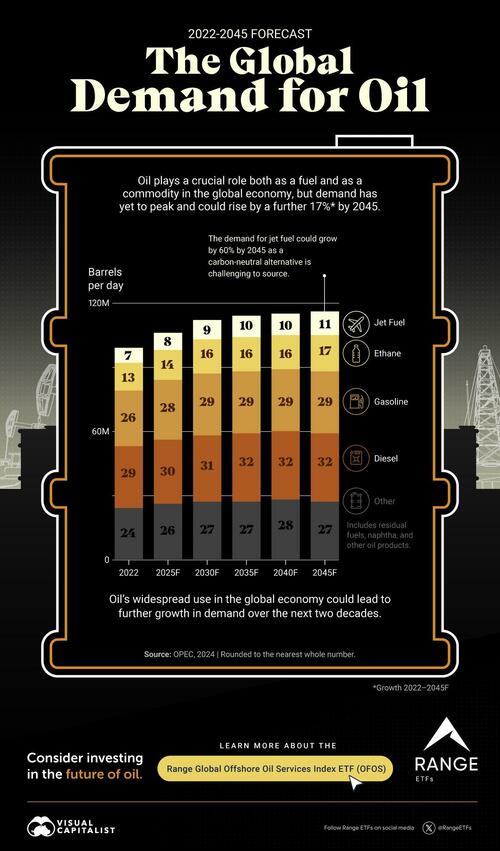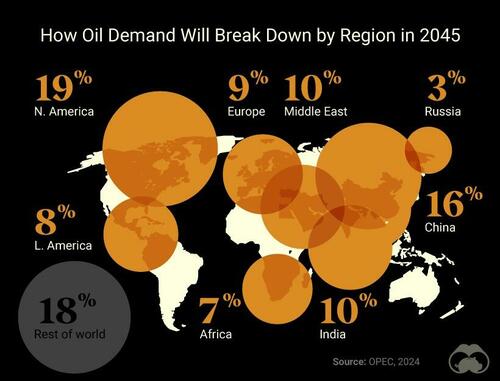Authored by Doug Casey via InternationalMan.com,
A lot of people would like political solutions to their problems, i.e., getting the government to make other people do what they want. People with any moral sense, however, recognize that can only create more problems.
Clever players, therefore, use the government as a tool but do so from behind a curtain. They know that it’s more effective, and a lot safer, to pull the puppet’s strings from offstage. Sometimes, they step into the limelight, depending on the circumstances and the depth of their personal narcissism. But they’re all about two things: Power and money. Call them the Deep State.
Once a country develops an entrenched Deep State, only a revolution or a dictatorship can turn things around. And probably only in a small country.

The American Deep State is a powerful informal network which controls most institutions. You won’t read about it in the news because it controls the news. Politicians won’t talk about it or even admit that it exists. That would be like a mobster discussing murder and robbery on the 6 o’clock news. You could say the Deep State is hidden, but it’s hidden in plain sight.
The Deep State is involved in almost every negative thing that’s happening right now. It’s essential to know what it’s all about.
The State
The Deep State uses and hides behind the State itself.
Even though the essence of the State is coercion, people have been taught to love and respect it. Most people think of the State in the quaint light of a grade school civics book. They think it has something to do with “We the People” electing a Jimmy Stewart character to represent them. That ideal has always been a pernicious fiction because it idealizes, sanitizes, and legitimizes an intrinsically evil and destructive institution, which is based on force. As Mao once said, political power comes out of the barrel of a gun.
The Deep State
The Deep State itself is as old as history. But the term “Deep State” originated in Turkey, which is appropriate since it’s the heir to the totally corrupt Byzantine and Ottoman empires. And in the best Byzantine manner, our Deep State has insinuated itself throughout the fabric of what once was America. Its tendrils reach from Washington down to every part of civil society. Like a metastasized cancer, it can no longer be easily eradicated.
In many ways, Washington models itself after another city with a Deep State, ancient Rome. Here’s how a Victorian-era freethinker, Winwood Reade, accurately described it:
“Rome lived upon its principal till ruin stared it in the face. Industry is the only true source of wealth, and there was no industry in Rome. By day the Ostia road was crowded with carts and muleteers, carrying to the great city the silks and spices of the East, the marble of Asia Minor, the timber of the Atlas, the grain of Africa and Egypt; and the carts brought out nothing but loads of dung. That was their return cargo.”
The Deep State controls the political and economic essence of the US. This is much more than observing that there’s no real difference between the left and right wings of the Demopublican Party. Anyone with any sense (that is, everybody except the average voter) knows that although the Republicans say they believe in economic freedom (but don’t), they definitely don’t believe in social freedom. And the Democrats say they believe in social freedom (but don’t), but they definitely don’t believe in economic freedom.
Who Is the Deep State?
The American Deep State is a real but informal structure that has arisen to not just profit from but control the State.
The Deep State has a life of its own, like the government itself. Within the government, it’s composed of top-echelon employees of a dozen Praetorian agencies, like the FBI, CIA, and NSA…top generals, admirals, and other military operatives…long-term congressmen and senators…and directors of important regulatory agencies.
But the Deep State is much broader than just the government. It includes the heads of major corporations, all of whom are heavily involved in selling to the State and enabling it. That absolutely includes Silicon Valley, although those guys at least used to have a sense of humor, evidenced by their defunct “Don’t Be Evil” motto.
It also includes the top people in the Fed, and the heads of the major banks, brokers, and insurers. Add the presidents and many professors at top universities, which act as Deep State recruiting centers… top media figures, of course… and many regulars at things like the WEC, Bohemian Grove, and the Council on Foreign Relations. They epitomize the status quo, held together by power, money, and propaganda.
Altogether, I’ll guess these people number a couple thousand. You might analogize the structure of the Deep State to a huge pack of dogs. The people I’ve just described are the Top Dogs.
But there are hundreds of thousands more who aren’t at the nexus but who directly depend on them, have considerable clout, and support the Deep State because it supports them. This includes many of the wealthy, especially those who got that way thanks to their State connections… the 1.5 million people who have top secret clearances (that’s a shocking but accurate number), plus top players in organized crime, especially the illegal drug business, little of which would exist without the State. Plus mid-level types in the police and military, corporations, and non-governmental organizations.
These are what you might call the Running Dogs.
Beyond that are the scores and scores of millions who depend on things remaining the way they are, like the 50%-plus of Americans who are net recipients of benefits from the State—the 70 million on Social Security, the 90 million on Medicaid, the 50 million on food stamps, the many millions on hundreds of other programs, the 23 million government employees and most of their families. In fact, let’s include the many millions of average Joes and Janes who are just getting by.
You might call this level of people, the vast majority of the population, Whipped Dogs. They both love and fear their master; they’ll do as they’re told and roll over on their backs and wet themselves if confronted by a Top Dog or Running Dog who feels they’re out of line. These three types of dogs make up the vast majority of the US population. I trust you aren’t among them. I consider myself a Lone Wolf in this context and hope you are, too. Unfortunately, however, dogs are enemies of wolves and tend to hunt them down.
The Deep State is destructive, but it’s great for the people in it. And, like any living organism, its prime directive is: Survive! It survives by indoctrinating the fiction that it’s both good and necessary. However, it’s a parasite that promotes the ridiculous notion that everyone can live at the expense of society.
Is it a conspiracy headed by a man stroking a white cat? I think not. It’s hard enough to get a bunch of friends to agree on what movie to see, much less a bunch of power-hungry miscreants bent on running everyone’s lives. But, on the other hand, the Top Dogs all know each other, went to the same schools, belong to the same clubs, socialize, and, most importantly, have common interests, values, and philosophies.
The American Deep State rotates around the Washington Beltway. It imports America’s wealth as tax revenue. A lot of that wealth is consumed there by useless mouths. And then, it exports things that reinforce the Deep State, including wars, fiat currency, and destructive policies. This is unsustainable simply because nothing of value can come out of a city full of parasites.
A SOLUTION?
Many Americans undoubtedly believe Donald Trump is a solution to what ails the US. They think he’s a maverick who will smash the Deep State. That’s understandable since he’s a cultural conservative. He wants the country to resemble the happy days of yesteryear, when Mom, apple pie, and Chevrolets were more important than Diversity, Equity, and Inclusion. He’s a nationalist, a traditionalist, and business-oriented. That’s all very well. But irrelevant to the Deep State.
The problem is that Trump will almost necessarily surround himself with Deep State players; they’re really all there is in and around the Washington Beltway, Wall Street, Academia, or the media. He’s not about to abolish government agencies (although he might prune a few) and fire scores of thousands of government employees. His lack of a philosophical core will guarantee that instead of trying to abolish the State (in the manner of Millei or Ron Paul), he’ll just use it in ways he thinks are righteous. The proof of that is the trillions of new government spending and deficits he approved of when he was in power. He’ll spend trillions more if he’s re-elected. And all of it will feed the Deep State.
On the bright side, if Trump is elected, his rhetoric will be less objectionable than Kamala’s. There will probably be less overtly disastrous legislation enacted, and some regulations will likely be cut back.
On the not-so-bright side, I’m afraid the Democrats could win come November. They have control of the apparatus of the State, and they absolutely don’t want to give it up. The Deep State will be just fine if Trump wins, of course. But nobody wants to take a chance; there might be some broken rice bowls. He might turn into a loose cannon. So the Deep State, the Establishment, will be even fatter and happier if the Dems take control.
That’s what they’ll work for. And that’s the way to bet.
* * *
It’s clear there are some ominous social, political, cultural, and economic trends playing out right now. Many of which seem to point to an unfortunate decline of the West. That’s precisely why legendary speculator Doug Casey and his team just released this free report, which shows you exactly what’s happening and what you can do about it. Click here to download it now.







